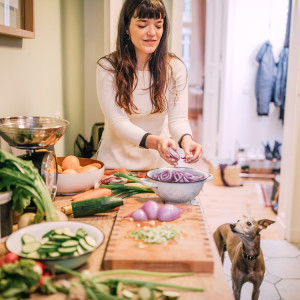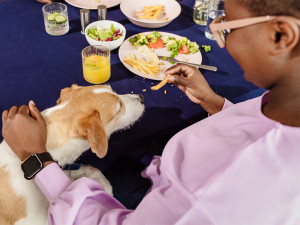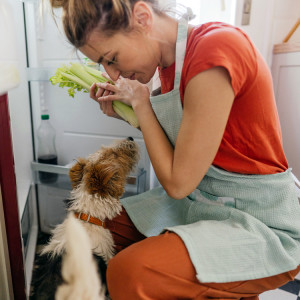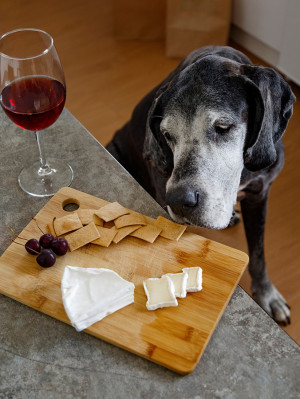Can Dogs Eat Garlic?
Like vampires, they should stay far away. Here’s why.

share article
Garlic is a cooking staple found in cuisines world-wide but it is one food your dog definitely should not eat. Garlic is toxic to dogs and causes serious illness when enough of it is consumed. Since garlic is such a common addition to prepared dishes, it is important to check the ingredients on any foods you plan to share with your pup.
Read on to learn more about the dangers of garlic for dogs.
Nutrition facts about garlic for dogs
Garlic grows underground as the bulb of the plant, Allium sativum. When the plant is harvested, the bulbs are dried out and this allows them to be preserved for use in cooking. Other edible plants of the Allium family include onions, chives, and leeks, which all have some similar properties to garlic. In addition to being an integral ingredient in many recipes, garlic is often touted as having medicinal properties and has been used in traditional medicine for ages.
Some health claims about garlic include anti-inflammatory, antimicrobial, and anti-cancer propertiesopens in a new tab, along with many other claims that have not been scientifically evaluated. There are also claims that garlic can be used to prevent and/or treat fleas in dogsopens in a new tab; however, this is not an effective way to treat fleas and can put them at risk for serious illness related to garlic toxicity.
Is garlic good for dogs?
Garlic is not good for dogs and is in fact toxic to them if they ingest enough of it. This is due to a compound in garlic known as N-propyl disulfide as well as some additional sulfides found in garlic and all plants in the Allium family. These compounds cause oxidative damage to red blood cells, which causes them to burst, or lyse, resulting in a condition called hemolytic anemia.
In these cases, the overall number of healthy red blood cells declines and this anemia can cause dogs to feel lethargic, weak, have pale gums, difficulty breathingopens in a new tab, a racing heart rate, and could lead to more serious collapse and/or death in extreme cases. Dogs with hemolytic anemia may also have a yellow tint to their skin and dark urine due to the breakdown of red blood cells.
These compounds can also cause damage to the digestive tract, resulting in pain and diarrheaopens in a new tab. Signs of a toxicity can take up to seven days to show up, and dogs can get sick both from eating a large amount in one sitting as well as after repeated ingestions of smaller amounts of garlic over time. The toxic compounds in garlic and other Allium plants are not affected by cooking or the freshness of the garlic, so it can be just as toxic in its dried and cooked forms.
Can dogs eat foods cooked with garlic powder?
Dogs should not eat foods containing garlic powder, garlic salt, or any garlic products. This is because even in its dried form used for seasoning, the toxic compounds are still active. They can even be more concentrated in their dehydrated form, meaning dogs can get sick from eating a smaller amount of garlic powder compared to the amount of fresh garlic required to cause symptoms.
Of course, a dog still has to ingest enough based on their body weight to get sick and a food prepared with a small sprinkling of garlic powder may not be enough to cause any symptoms. However, regular ingestion of smaller amounts of garlic can still cause problems over time, and smaller dogs will be more at risk for illness compared to larger ones. The safest option is to avoid it altogether and to contact a pet-poison hotline right away if you are concerned that your dog ingested garlic.
Is garlic completely safe for dogs?
Garlic is a known toxin to dogs along with all edible plants in the Allium family. This includes onionsopens in a new tab, chives, leeks, and ramps. None of these plants are safe to share with your dog and should be kept far out of reach.
Some studies have suggested that garlic contains the most concentrated amounts of the toxic compound but that onion toxicity tends to be more common due the amount used in cooking. And while the amounts of each plant required to cause illness will vary, the safest option is to avoid them altogether when it comes to your pup.
What are the signs of garlic toxicity in dogs?
Garlic toxicity can cause a number of different signs and some signs may develop many days after eating garlic.
These include:
Digestive upset: At both lower doses and higher doses, garlic can cause irritation to the lining of the digestive tract, leading to pain, loss of appetiteopens in a new tab, and/or diarrhea.
Lethargy: Dogs who have developed anemia feel very weak. They may get tired more easily, sleep throughout the day, or in more extreme cases, be unable to stand or walk.
Rapid breathing: Dogs with more severe anemia are not able to get enough oxygen to their tissues and organs. To compensate, they breathe rapidly and may take quick, shallow breaths.
Pale or yellow gums: Red blood cells give the gums and other tissues their bright pink hue. As a result of anemia, or loss of red blood cells, animals may have very pale pink or white gums. This particular kind of anemia causes the red blood cells to break apart, which can also lead to a yellowish tint to the tissues, known as jaundice.
Dark urine: As red blood cells break down, they release pigments that can make the urine appear very dark yellow or even brown in color.
The bottom line: Can dogs eat human food?
Dogs can eat lots of human foods, and there are many ways to incorporate safe and healthy fresh foods into their diet. However, this is a good reminder that not all foods are safe to share with your dog and there are some foods that can be toxic opens in a new tab to dogs even though they are perfectly safe for us. Always do your research to make sure the foods you want to share are safe for your dogopens in a new tab and speak with your vet or contact a pet poison hotline if you have any concerns.
It is also important to know that dogs have unique nutritional requirements, and they need to eat a complete and balanced dog food diet to meet their needs and be their healthiest. All treats and table foods should be kept to a minimum to ensure that they get most of their diet from a balanced source. This will also help prevent unintentionally overfeeding your pup by limiting access to snacks in addition to their meals.
Try to use treats sparingly, opens in a new tab and save them for times when you really need your dog’s attention, such as during training sessions, or when you want to provide enrichment through puzzle toys and games. If you need help determining how muchopens in a new tab to feed your dog, your vet can help calculate their exact caloric needs based on their age, reproductive status, activity level, and any medical conditions they have. There are always fun and creative ways to treat your dog to the occasional special snack as long as it is done mindfully.
Other foods that are safe for dogs
Eggs can be a healthy, high-protein snackopens in a new tab.
Pumpkin can be a high-fiber, nutritious choiceopens in a new tab.
Strawberries can be a safe option opens in a new tabin moderation, too.
Other foods that are dangerous
Chocolate is another food opens in a new tabthat is toxic to dogs.
Xylitol, an artificial sweeteneropens in a new tab found in many sugar-free foods and medications is toxic to pups as well.
Cheese and other high-fat dairy foods can cause digestive upsetopens in a new tab for many dogs, and more serious pancreatitis in some cases.
FAQs (People also ask):
How much garlic can a dog eat?
Garlic is toxic to dogs and they should not eat it.
Is it OK to give dogs garlic?
It is not a good idea to give dogs anything containing garlic, garlic powder, or garlic flavoring, as it is toxic.
Can dogs eat garlic?
Dogs should not eat garlic due to risks of toxicity that include digestive upset and more serious hemolytic anemia.
Is garlic good for dogs?
No, garlic is toxic to dogs and can make them very sick.
Can dogs eat any part of the garlic plant?
No, garlic and all plants of the Allium family are toxic to dogs, and they should not eat them.
References:

Dr. Amy Fox, DVM
Amy Fox, DVM is a small animal veterinarian in New York City. A lifelong animal lover, Dr. Fox studied biology in college and then worked as a veterinary nurse before pursuing veterinary school at Cornell University. She has worked in many different settings including shelter medicine, emergency medicine, general practice, and animal cruelty and forensics. She is especially interested in nutrition, preventative medicine and care for senior pets. Dr. Fox also enjoys writing about veterinary medicine and teaching. In her free time she loves to cook, garden, and go for long runs.
Related articles
![Staffordshire bull terrier dog eating grass]() opens in a new tab
opens in a new tab15 Things You Think Are Toxic for Dogs — But Actually Aren’t
From (human) prescription meds to poinsettia plants, these "toxic" items may not be so bad for your pup.
![Red-haired woman holding sleeping dog in her lap on the bed]() opens in a new tab
opens in a new tab6 Reasons Your Dog Is Vomiting
And how to help them feel better fast.
![A woman feeds her dog with a piece of fries during lunch.]() opens in a new tab
opens in a new tabCan Dogs Eat Potatoes?
We know they are your adorable little potato, but can they snack on one?
- opens in a new tab
Can Dogs Eat Celery?
Sure, they can have a bite—if they want one.
![Curious Basenji dog puppy climbs on the table with fresh vegetables at home in the kitchen.]() opens in a new tab
opens in a new tabCan Dogs Eat Broccoli?
Find out how to safely get your pup their greens.
- opens in a new tab
Can Dogs Eat Cheese?
We know they want to — but how much is safe?








